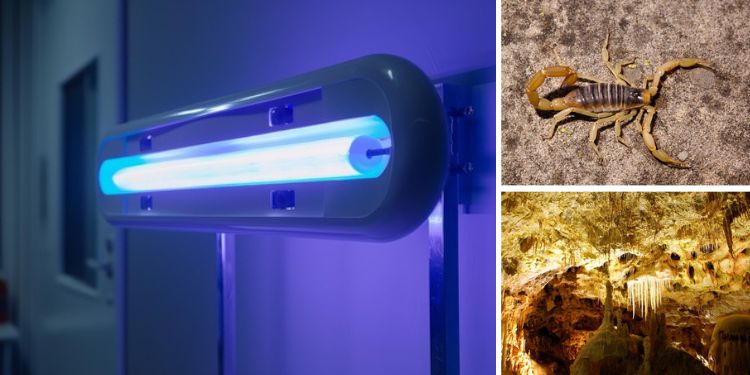Blacklights are devices that emit ultraviolet light, which can be extremely beneficial in survival situations. This type of light is beyond the spectrum of visible light that humans can see.
However, it is a form of electromagnetic radiation that can be absorbed by some materials that then convert the energy to visible light.
This process is called fluorescence, which is great for blacklight parties and detective shows, but there are also practical and potentially lifesaving uses for blacklights in survival situations.
Here are nine survival uses for a blacklight.
Water Purification
Certain blacklights can be very effective at purifying water. When used in conjunction with effective filtering, UV-C blacklights are extremely capable of neutralizing a wide range of microorganisms by causing severe damage to their DNA and making them incapable of replication.
Weaker UV-A blacklights are also capable of this but require the water to be in a clear plastic bottle and it takes significantly longer. To put the differences in perspective, UV-A (longwave) is used in tanning beds, while UV-C (shortwave) is used to purify water and air in healthcare settings.
In a survival situation, however, if you don’t have a blacklight, you can use this method to extract clean, drinkable water out of thin air. Water is one of the most vital resources for survival, and this technique might even save your life when SHTF.
Scorpion Detection
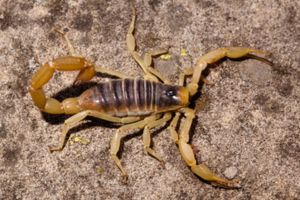 Scorpions are found in much of the southern and western reaches of the US and can be potentially dangerous.
Scorpions are found in much of the southern and western reaches of the US and can be potentially dangerous.
They love to crawl inside boots and packs at night, but luckily, their exoskeletons contain materials that fluoresce under blacklight, giving a blue-green glow that is easily spotted.
This can also be useful when traveling on foot or setting up camp at night if you want to check the area first.
Inspecting Gear for Fungal Growth
Fungal growth can be good or bad, depending on your situation. If you are foraging for food and need to continue your search into the night, chanterelles, honey, sweet tooth, and other species of edible mushrooms fluoresce under UV light.
Many toxic species also fluoresce, so you will need to know your mushroom identification beforehand. Many species of mold will fluoresce, so you can use a blacklight to check your gear or any potential sleeping area for growth before it gets out of hand or you unintentionally immerse yourself within their spores.
Prolonged exposure to certain fungi can lead to infections in the body, particularly respiratory or skin infections. If you inhale fungal spores or come into contact with contaminated surfaces, you may develop an infection that could require antibiotics.
Antibiotics will be very hard to come by in a crisis, when medical supplies are scarce and access to professional healthcare may be limited. You can’t generally buy antibiotics over the counter, so here is how to stockpile antibiotics without a prescription.
Wildlife Tracking
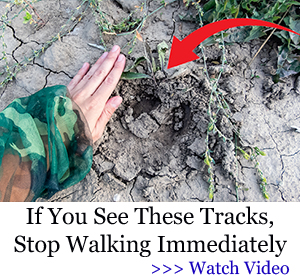 Blacklights are useful for wildlife tracking by making animal urine visible.
Blacklights are useful for wildlife tracking by making animal urine visible.
This can be used to track prey animals like deer, avoid predator animals like coyotes, or notice pest animals like mice.
Importantly, you can get a better picture of animal patterns by finding locations with an increased abundance of urine markers, giving you greater confidence to trap and hunt in those locations.
Catfish and certain carp will also fluoresce, making fishing easier. In coastal areas, clams and oysters often fluoresce, though the intensity may be very weak.
Checking for Cleanliness
Good hygiene is always important, but even more so in survival situations where one infection could spell your demise. Blacklights can be used to check for multi-faceted cleanliness. Older food can be checked for mold or bacterial growth. Water bottles can be checked for suspended debris and organic compounds and then potentially purified, as discussed earlier.
Sleeping areas, especially in urban survival situations, can be checked for urine, blood, saliva, and other bodily fluids. If you or someone in your party is injured and medical treatment is required, a blacklight can be used to check the treatment area and any medical tools being used for the presence of potentially infectious contamination.
Insect Luring
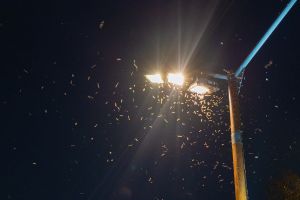 Much like regular light, blacklights attract insects’ attention. This can be useful if you want the insects to leave you alone by placing the light somewhat distant from your sleeping area to draw insects away. In more extreme survival situations, you may want to draw insects in for the purpose of consuming them. A blacklight can be very useful for either scenario.
Much like regular light, blacklights attract insects’ attention. This can be useful if you want the insects to leave you alone by placing the light somewhat distant from your sleeping area to draw insects away. In more extreme survival situations, you may want to draw insects in for the purpose of consuming them. A blacklight can be very useful for either scenario.
OpSec
Not all survival scenarios are limited to trekking through the wilds in search of civilization. When humans themselves threaten your survival, operational security becomes an important factor to consider. We only have so much mental capacity, and some important information may need to be written down.
Coordinates and routes to your bugout location, contact information, passwords, codes, cache locations, and observation logs can cause you great grief or loss if they fall into the wrong hands. Blacklights are fairly uncommon in regular life, so UV ink can be used to conceal this information in otherwise useless documents and remain visible to only you and your blacklight.
Emergency Light
Again, being fairly uncommon in regular life, a black light makes a good signal light that will attract attention if purposely used to do so. If you want to avoid attention, black lights can be used in a concealed fashion that is more difficult to detect than yellow or white light. This can be useful for stealthily searching an area or digging through your pack while in open areas.
If your survival involves an enemy with night vision capability, blacklights are safer to use as they are normally outside the visible spectrum of night vision devices. You can learn more here about how to avoid night and thermal vision when SHTF
Finding Minerals
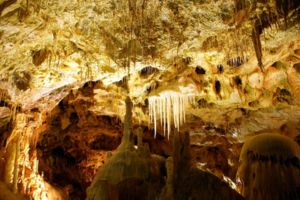 Calcite is calcium carbonate. It is one of the most common minerals on Earth and is frequently found in limestone, marble, seashells, stalactites, and stalagmites.
Calcite is calcium carbonate. It is one of the most common minerals on Earth and is frequently found in limestone, marble, seashells, stalactites, and stalagmites.
Depending on the type of blacklight you have and the impurities of the mineral, calcite commonly fluoresces red, blue, orange, or yellow.
The raw mineral can be collected and then dropped as a bread trail to find your way back to camp after dark or as markers to designate areas of interest.
Stalactites and stalagmites are the conical structures protruding from the ceilings and floors of caves. By using a blacklight, you will be able to see these structures and not only avoid injuring yourself on them but can use them to increase your spatial awareness and navigational abilities while within caves. A white or yellow light will generally be better for this purpose, but a blacklight can add additional awareness and simultaneously show residue traces from animals and humans that may still be in the cave.
Calcite is quite common in mining operations, and finding piles of it could lead you to mineshafts that can be used for shelter or for scavenging. Lead, copper, and zinc are commonly associated with calcite and can all be easily melted and used in survival situations with limited resources. Concentrations of calcite within the mineshaft will help you pinpoint the best areas to collect.
Practical survival uses of blacklights are abundant, especially with practice and some complimentary training in mineralogy, biology, hunting, and foraging. It is important to know that there are longwave and shortwave blacklight spectrums, and you will need both to get the full benefits of blacklights in survival situations. Luckily, many consumer blacklights allow you to select between each spectrum. A simple blacklight keychain can be extremely useful for detection purposes, but you will want a dedicated device for water purification and more energy-intensive functions.
What are some other survival uses for blacklights? Let us know below!
You may also like:
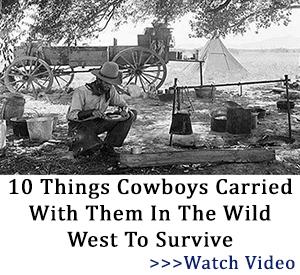 30 Long Lasting Recipes Grandma Made During WWII
30 Long Lasting Recipes Grandma Made During WWII
How to Tell If You’re an Easy Looter Target
Best States for Looters. Do You Live in One of Them?
12 Items That Are Still Good After They Go Bad
DIY EMP-Proof Truck
Read the full article here
